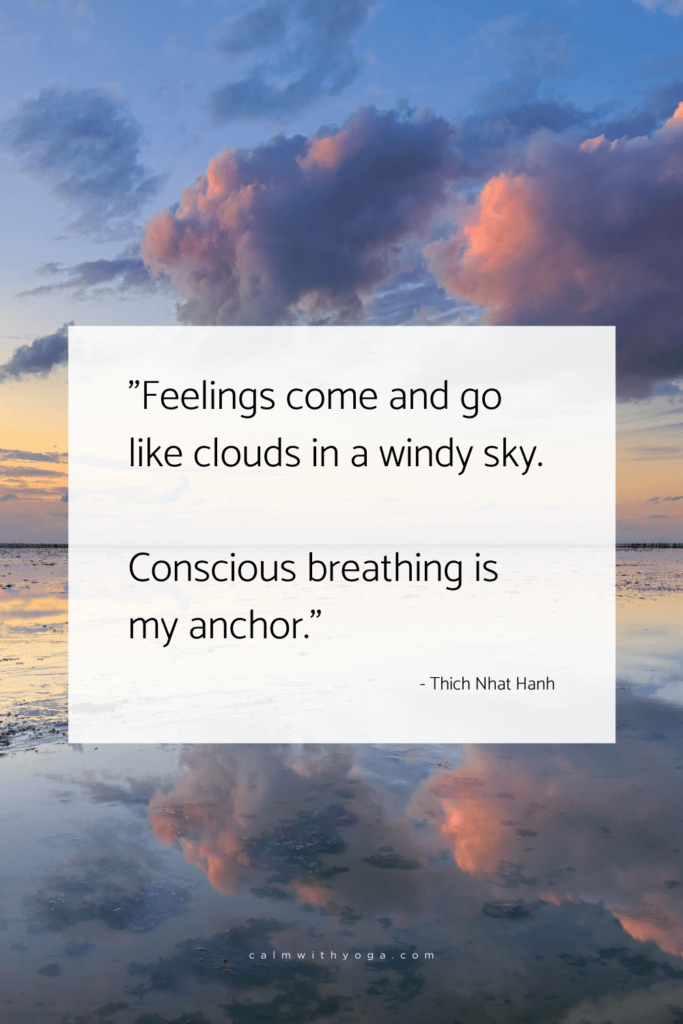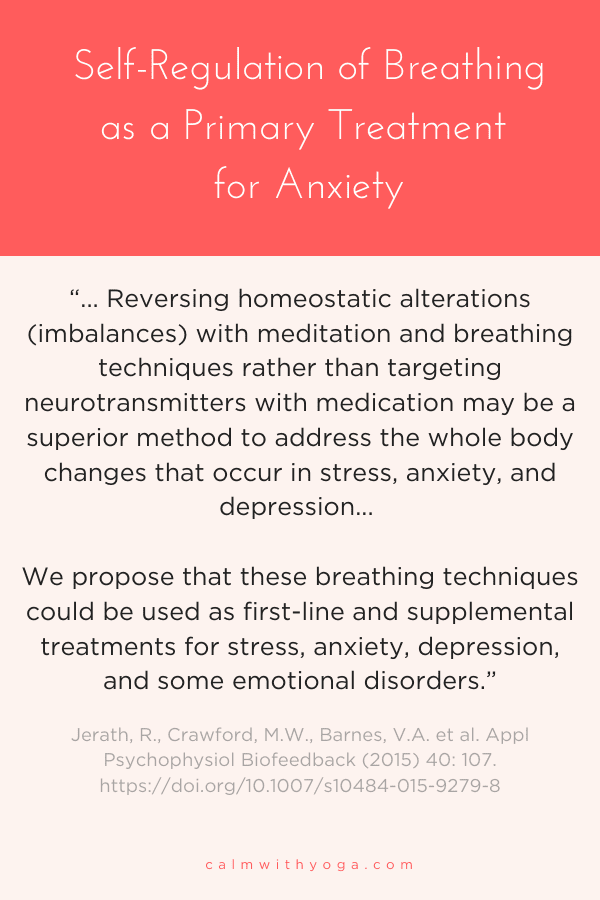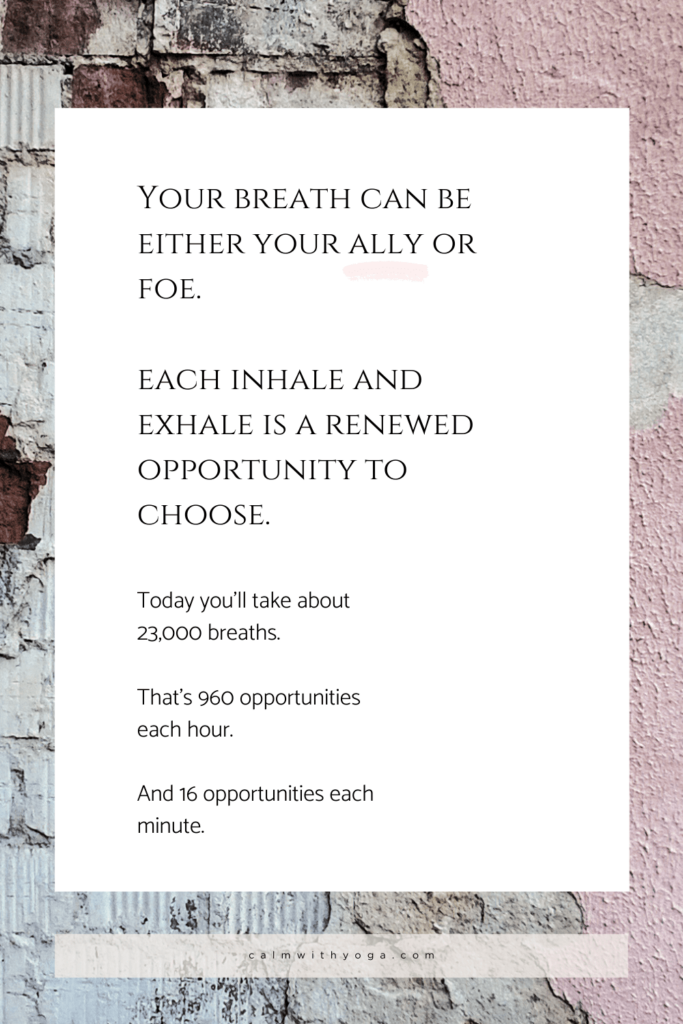Breath is the bridge which connects life to consciousness, which unites your body to your thoughts.
Whenever your mind becomes scattered, use your breath as the means to take hold of your mind again.
Thich Nhat Hanh, Buddhist monk and meditation teacher
You breathe an average of 17,280 – 23,040 times every.single.day of your life. (1)
Because it’s the one act you do 24/7 non-stop, you probably don’t give it much thought.
And yet, right under your nose, you carry with you one of the most potent built-in stress-busting assets at your disposal.
Your breath can be your ally or your foe.
As your ally, it helps you combat stress, overwhelm, anxiety, unnecessary irritability, and emotional reactions.
As your foe, it actually contributes to all of those things.
If you don’t control your breath, your breath will control you…

If you haven’t developed the daily habit of breath awareness, chances are you’re not in control of your breath.
This means that at any given moment of any given day, your breathing might be working against you and adding to your stress load.
When you take back your breath through conscious, deliberate awareness and intentional control, you take back your physiology.
When you take back your physiology, you take control of your mind, mood, emotions, and body. (And your life juggling skills improve, too.)
Proven mental, emotional, and physical health benefits of breathing properly:

Intentional breathing affects the whole body and activates your body’s relaxation/rest response.
This is because your breath acts as a switching station for your nervous system, specifically between the two branches of your autonomic nervous system: the sympathetic nervous system (stress response), and the parasympathetic nervous system (relaxation/rest response.)
Deep, slow breathing de-stresses and relaxes you, and also engages your sympathetic in ways that work for you, not against you.
In this way, deep breathing exercises help send your body signals of safety so that you can enter into a higher state of functioning – one that is healing, regenerating, and conducive to a balanced calm state. (2)

Belly breathing (aka: diaphragmatic breathing) is especially effective at calming the mind and increasing well-being.
Intentional deep breaths may also be an effective option for treating emotional and mental health conditions such as stress, anxiety, and depression. (3)
Just do a Google search and you’ll find numerous studies and other literature published on this subject, like this one published in the Journal of Applied Psychophysiology and Biofeedback:

Intentional breathing also offers various other equally important physical health benefits:
- Lowers blood pressure and heart rate, and is even recognized by the FDA (Food & Drug Administration) in the treatment of hypertension. (4)
- Maintains pH balance of your bloodstream, creating a balance between acidity and alkalinity. (5)
- Boosts the immune system by promoting white blood cell containing lymph fluid movement in the body. (6)
- Helps detox the body by stimulating lymphatic movement. (7)
- Promotes ahealthy gutand your digestion in tip-top shape. Deep breathing can also help prevent acid reflux, bloating, intestinal spasms, and hiatal hernia. (8)
- Can increase theta brain waves.(9)Theta brainwaves are associated with the state of deep relaxation and dreaming sleep, as well as increased creativity, super-learning, integrative experiences, and increased memory. (10)

The Breath-Emotion Loop
– How Losing Control One Means Losing Control Of The Other

Emotions and breath are known to have a deep relationship.
Animals such as the rat and rabbit have fast breathing and so are extremely nervous, mentally unstable, emotionally restless, and live only for short period of time.
In contrast, the elephant and turtle are slow, deep breathers and consequently have calmer personality and longer lives.
– Dr. Ananda Balayogi Bhavanani, Yoga researcher
How breath impacts emotions:
Emotions and breathing rhythms have a two-way, symbiotic relationship because they both impact one another.
This creates what I call the Breath-Emotion Loop.
Breathing rhythms (aka: the way you breathe) can be fast or slow, shallow or deep, short or long.
Breathing rhythms send messages to your body that affect your mood, your stress levels, and even your immunity. (11)
One study by Northwestern University on how breathing rhythms impact fear, emotional recognition, and memory found how breathing links to changes in behavior:
“The rhythm of breathing creates electrical activity in the human brain that enhances emotional judgments and memory recall. These effects on behavior depend critically on whether you inhale or exhale and whether you breathe in through the nose or mouth.” (12)

Their tests recorded brain activity fluctuating with breathing, thus indicating a direct connection between the two.
The way you breathe can literally change your emotional and mental state.
If you breathe fast and shallow, your brain’s arousal center becomes hyperactivated. This can lead to increased alertness, wakefulness, excitement, or anxiousness.
If you breathe slow, deep, and long, you’ll become calmer because the arousal part of your brain isn’t being activated. (13)

The reverse: how emotions impact breathing:
Heightened emotional states influence the body’s breathing mechanism.
Feeling angry, anxious, excited, tense, or scared translates to short and shallow breathing.
Feeling relaxed, serene, or content translates to longer, slower, deeper breaths.
Our breath automatically responds to our emotional shifts. That is – until we consciously control it.
Emotions cause changes in the body, and breathing is one of the bodily processes most impacted by emotions. (14)
Developing daily breath awareness

Since breath and emotions are inextricably linked together, we can learn to use one to influence the other.
The moments when we’re most stressed, anxious, angry, afraid, overworked, and overwhelmed are precisely the moments when we most need to bring awareness and consciousness to our breath.
These are the moments where we can take back control by taking back our breath.
The next time you find yourself experiencing any heightened emotion, see if you can catch yourself in the moment and pay attention to the breathing patterns that come along with it.
Start noticing the breathing patterns that accompany moments like:
- having an argument with someone
- being deep in thought or lost in your work or what you’re doing
- having an uncomfortable conversation
- being upset and crying
- waiting for results of some kind, like health test results
- having a laughing attack
- experiencing an orgasm
Since many heightened emotional moments tend to take us out of our bodies to focus on the outside or on what’s happening, it’ll require some intention and work on your part to tune into how your body is responding via your breath.
By observing yourself during these moments you’ll be able to experience firsthand the link between your breathing and your emotions and your mood.
Did you just have a big fight?
How’s your breath?
Fast and short?
Do you feel hot?
Are palms sweaty?
Can you feel your heart beating through your chest?
A Simple Breath Awareness Meditation:

The more we create a meditation practice through the awareness of the breath the more we’ll tap into the present moment.
Get into a comfortable position and simply start to follow the natural rhythm of your breath.
Notice the out-breath and how your body feels as your lungs empty of air.
If the mind wanders, that’s totally fine and normal…
Just bring your awareness back to the breath and resume mindful breathing.
This simple breathing technique serves as both a breathing meditation and a mindfulness meditation.
Bring attention back to your breath…
How’s your breathing?
Stop and notice.
Observe.
Are you unconsciously holding your breath?
Breathing short and shallow from your chest?
Breath…
Inhaling…
Exhaling…
Keep going.
Stay present with it.
Here’s a more in-depth guided breath awareness meditation that will teach you to breathe like a Buddhist monk.
The skill of breath awareness can be learned.
It’s a self-reflective habit that can be programmed into your mind with enough repetition.
Try this little exercise:
Preprogram a reminder on your phone to go off every 2-3 hours to help you check in with yourself throughout the day.
This will serve as a nudge or a soft tap on your shoulder prompting you to assess the state of your breath at any given moment throughout the day.
A simple “How’s your breathing?” or “Notice your breath” coming up on your phone screen can really go a long way in developing breath awareness.
We are all born with an innate healing tool right in the center of our chests.
Your breath can create union within yourself and with your world, or it can create more separation and strain.
You can begin to take control of your mind, mood, emotions, and body by taking control of your breath and by using it as feedback.

What will you choose?

What will you choose?
REFERENCES
:
(1)https://blog.epa.gov/blog/2014/04/how-many-breaths-do-you-take-each-day/
(2)https://www.youtube.com/watch?v=VAL-MMYptQc
(3)https://link.springer.com/article/10.1007/s10484-015-9279-8
(4) http://hyper.ahajournals.org/content/46/4/714.short
(5)http://www.merckmanuals.com/home/hormonal-and-metabolic-disorders/acid-base-balance/overview-of-acid-base-balance
(6)Jahnke O.M.D., Roger (2013-07-02). The Healer Within: Using Traditional Chinese Techniques To Release Your Body’s Own Medicine *Movement *Massage *Meditation *Breathing (p. 40). HarperCollins.
(7)https://drhealthbenefits.com/lifestyle/healthy/healthy-habits/health-benefits-of-deep-breathing-exercise
(8) Matveikova, Irina (2014-06-16). Digestive Intelligence: A Holistic View of Your Second Brain (p. 159). Findhorn Press.
(9)https://www.ncbi.nlm.nih.gov/pubmed/16624497
(10)http://www.centerpointe.com/articles/articles-research
(11)https://fitness.mercola.com/sites/fitness/archive/2016/12/02/controlled-breathing.aspx
(12)https://www.sciencedaily.com/releases/2016/12/161207093034.htm
(13)http://time.com/4718723/deep-breathing-meditation-calm-anxiety/
(14)https://www.ncbi.nlm.nih.gov/pubmed/18487316












